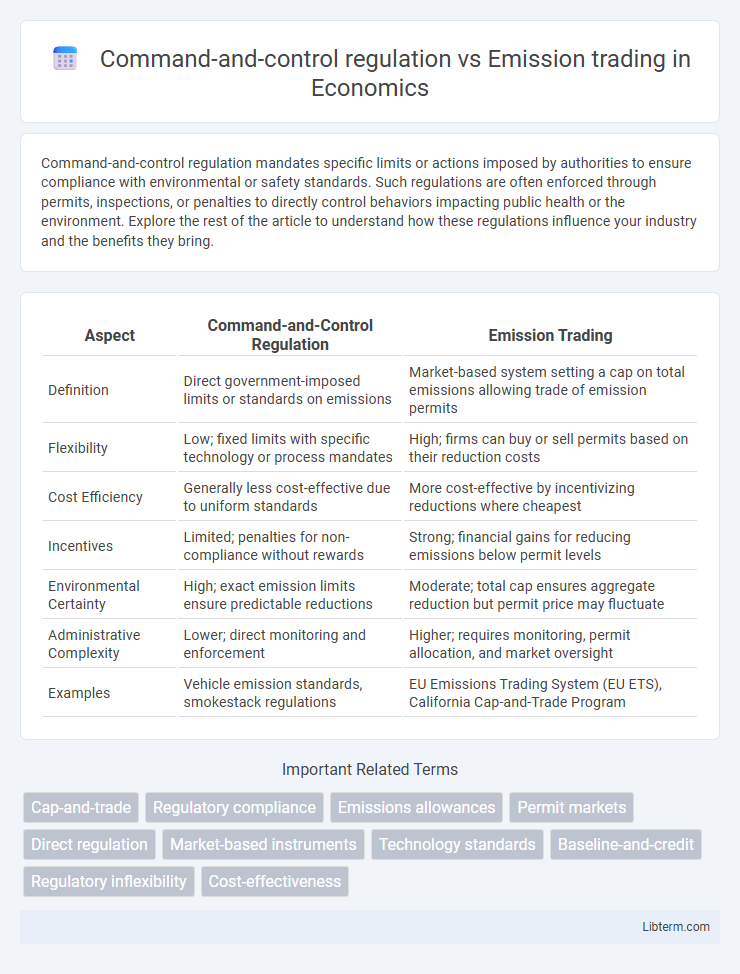Command-and-control regulation mandates specific limits or actions imposed by authorities to ensure compliance with environmental or safety standards. Such regulations are often enforced through permits, inspections, or penalties to directly control behaviors impacting public health or the environment. Explore the rest of the article to understand how these regulations influence your industry and the benefits they bring.
Table of Comparison
| Aspect | Command-and-Control Regulation | Emission Trading |
|---|---|---|
| Definition | Direct government-imposed limits or standards on emissions | Market-based system setting a cap on total emissions allowing trade of emission permits |
| Flexibility | Low; fixed limits with specific technology or process mandates | High; firms can buy or sell permits based on their reduction costs |
| Cost Efficiency | Generally less cost-effective due to uniform standards | More cost-effective by incentivizing reductions where cheapest |
| Incentives | Limited; penalties for non-compliance without rewards | Strong; financial gains for reducing emissions below permit levels |
| Environmental Certainty | High; exact emission limits ensure predictable reductions | Moderate; total cap ensures aggregate reduction but permit price may fluctuate |
| Administrative Complexity | Lower; direct monitoring and enforcement | Higher; requires monitoring, permit allocation, and market oversight |
| Examples | Vehicle emission standards, smokestack regulations | EU Emissions Trading System (EU ETS), California Cap-and-Trade Program |
Introduction to Environmental Regulation Approaches
Command-and-control regulation mandates specific limits or technologies for polluters, ensuring compliance through legal standards and enforcement mechanisms. Emission trading leverages market-based incentives by allowing firms to buy and sell emission permits, promoting cost-effective pollution reduction. Both approaches aim to mitigate environmental harm but differ in flexibility, administrative complexity, and economic efficiency.
Defining Command-and-Control Regulation
Command-and-control regulation refers to government-mandated limits on pollutant emissions that specify allowable levels or technologies to control pollution, ensuring compliance through penalties or sanctions. This regulatory approach mandates uniform standards, such as emission limits or required pollution control equipment, regardless of individual firm costs or efficiency. It contrasts with market-based mechanisms by directly controlling environmental outcomes rather than incentivizing reductions through tradable permits or pricing strategies.
Explaining Emission Trading Systems
Emission Trading Systems (ETS) are market-based approaches that allocate or auction a limited number of emission permits to companies, allowing them to buy, sell, or trade these allowances based on their emission levels. This flexible mechanism incentivizes organizations to reduce greenhouse gas emissions cost-effectively by creating a financial value for emission reductions. ETS contrasts with command-and-control regulation by promoting innovation and efficiency through market signals rather than prescribing specific emission limits or technologies.
Key Differences Between Command-and-Control and Emission Trading
Command-and-control regulation sets specific limits or technology standards for pollutants, mandating compliance through government enforcement, while emission trading creates a market for pollution permits that companies can buy or sell, encouraging cost-effective emissions reductions. Command-and-control offers clear, direct control over pollution levels but often lacks flexibility and economic efficiency compared to emission trading systems, which incentivize innovation by allowing firms to find the cheapest way to reduce emissions. Emission trading caps total emissions but lets market forces determine individual firm compliance, whereas command-and-control imposes uniform requirements regardless of cost differentials.
Environmental Effectiveness: A Comparative Analysis
Command-and-control regulation mandates specific emission limits or technology standards, ensuring predictable environmental outcomes but often lacking flexibility for firms. Emission trading systems, such as cap-and-trade, create market incentives for reducing pollutants by allowing firms to buy and sell emission permits, which can achieve cost-effective reductions while maintaining overall environmental targets. Empirical studies show emission trading programs, like the U.S. Acid Rain Program, have delivered superior environmental effectiveness in reducing sulfur dioxide emissions compared to traditional command-and-control approaches.
Economic Efficiency and Cost Implications
Command-and-control regulation mandates specific limits or technologies for pollution reduction, often resulting in uniform standards that may not reflect individual firms' abatement costs, leading to inefficiencies and higher overall compliance expenses. Emission trading systems create market-based incentives by allowing firms to buy and sell pollution permits, promoting cost-effective reductions where marginal abatement costs vary, thereby enhancing economic efficiency. Studies indicate that emission trading reduces total compliance costs by enabling flexibility, while command-and-control approaches can impose rigid standards that increase economic burdens on regulated entities.
Flexibility and Innovation Potential
Command-and-control regulation imposes specific limits or technology requirements, restricting flexibility and often stifling innovation by mandating uniform standards. Emission trading systems (cap-and-trade) offer flexibility by allowing firms to buy and sell emission permits, incentivizing cost-effective pollution reduction and fostering technological advancements. Market-based mechanisms create adaptive frameworks where companies innovate to minimize compliance costs, driving dynamic environmental improvements.
Implementation Challenges and Practical Considerations
Command-and-control regulation faces implementation challenges such as rigid standards that may not account for firm-specific differences, leading to higher compliance costs and enforcement difficulties. Emission trading systems require robust monitoring, reporting, and verification mechanisms to prevent fraud and ensure accurate emissions accounting, posing significant administrative burdens. Both approaches demand careful design to balance environmental effectiveness with economic efficiency and stakeholder acceptance.
Case Studies: Global Experiences and Outcomes
Command-and-control regulations mandate specific emission limits or technologies, as seen in the U.S. Clean Air Act's success in reducing sulfur dioxide through direct caps. Emission trading systems, exemplified by the European Union Emissions Trading Scheme (EU ETS), leverage market mechanisms to lower carbon emissions cost-effectively, driving innovation and economic efficiency. Comparative case studies reveal that while command-and-control ensures compliance certainty, emission trading offers flexibility and cost savings but requires robust monitoring to prevent market manipulation.
Future Trends in Environmental Regulation
Future trends in environmental regulation indicate a gradual shift from traditional command-and-control approaches towards market-based mechanisms like emission trading systems, which offer greater flexibility and cost-effectiveness in reducing greenhouse gas emissions. Advanced digital technologies and real-time data monitoring are enhancing the efficiency of emission trading, enabling more precise caps and trading quotas aligned with climate goals. Policymakers are increasingly integrating carbon pricing with command-and-control measures to balance strict environmental standards and incentivize innovations in low-carbon technologies.
Command-and-control regulation Infographic

 libterm.com
libterm.com